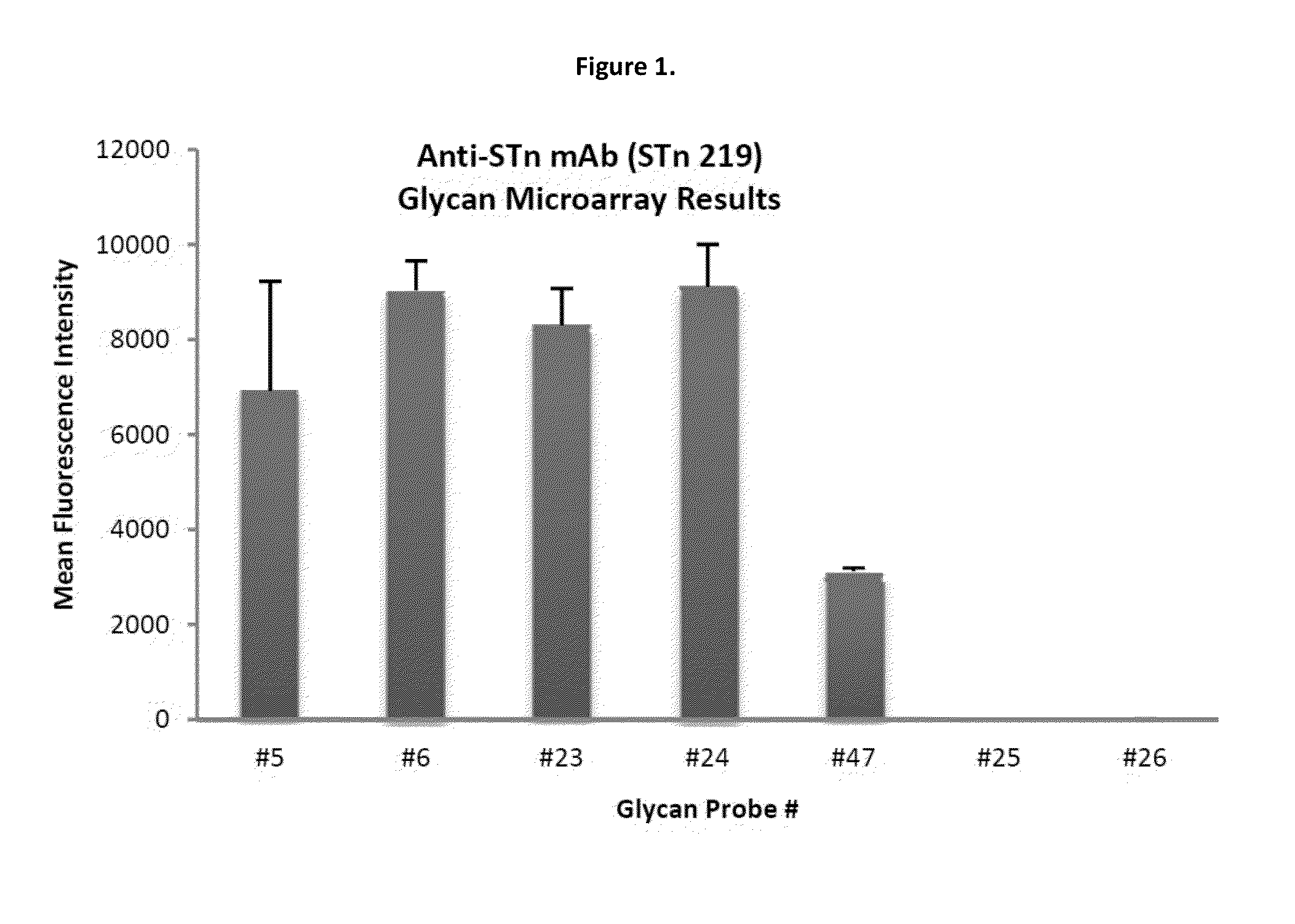Glycan-interacting compounds
a technology of glycans and compounds, applied in the field of compounds, can solve the problems of poor antibody yield, difficult to gain immunity against a “self” molecule, and major drawbacks of available antibodies
- Summary
- Abstract
- Description
- Claims
- Application Information
AI Technical Summary
Benefits of technology
Problems solved by technology
Method used
Image
Examples
example 1
Monoclonal Anti-GcSTn, Methods for Generation and Myeloma Cell Production
[0321]GcSTn-containing porcine submaxillary mucin (PSM) is extracted from porcine submaxillary glands, and injected into Cmah− / − mouse. Wild type mice possess a functional Cmah gene, and biosynthesize high level of endogenous Neu5Gc. Therefore, without wishing to be held by theory, using Cmah− / − mouse increases the immune response against GcSTn. The mouse serum is evaluated for the production of anti-GcSTn antibodies using EIA (a modified ELISA that specifically identifies Neu5Gc and other sialic acids). The serum of the mice that are positive for the expression of GcSTn are further evaluated for anti-GcSTn specificity of the antibodies produced by use of our unique glycan microarray, which includes two different forms of STn, GcSTn and AcSTn. The mice are selected for establishment of anti-GcSTn-producing hybridoma, following standard procedures.
Development of Cmah− / − Mouse Myeloma, and Establishment of Hybrid...
example 2
Porcine Submaxillary (PSM) Mucus Production
[0342]150 cryoground submaxillary glands (Pelfreeze Biologicals, Rogers, Ark.) were purchased and kept frozen at −20° C. until use. 700 g of cryoground glands were weighed and added to a 4 L beaker with 3.5 L of purified water. The solution was stirred at 4° C. for 6-8 hours using a magnetic stir bar. Stirring was then halted and the solution was allowed to settle overnight at 4° C. A funnel (10 inch diameter) was prepared by fluffing about 2 inches of glass wool and softly plugging the bottom of the funnel. About 4 inches of glass wool was then fluffed and layed on top of the plug. Next, a mesh (Home Depot, Atlanta, Ga.) with 0.25 mm pores was placed on top. Supernatant from the submaxillary gland solution was collected at 4° C. by slowly filtering through the padded funnel. Solid waste caught in the filter was discarded. The filtered supernatant was acidified to pH 3.5 by slowly adding 40-50 ml of 1 M HCl while stirring. The solution was ...
example 3
Mouse Immunization
[0343]Mouse immunization was carried out by Explora Biolabs (San Diego, Calif.). 16 male Cmah − / − mice, ages 8-12 weeks were obtained and allowed to acclimate at least 3 days. Mice were given ad libitum access to standard diet (2920X.10, Global 18% Protein Rodent Diet from Harlan, San Diego, Calif.) and acidified water (pH 2.7-3.0) throughout the study period. The 16 mice were divided into two groups (Group 1 and Group 2, 8 mice / group), randomized based on body weight. During the study, animals were monitored for health and weighed twice per week (for a total of 8 time points).
[0344]Group 1 mice were vaccinated by subcutaneous injections of 100 μg of porcine submaxillary mucin (PSM) with Titermax adjuvant (CytRx Corporation, Los Angeles, Calif.). Each vaccination comprised 50 μl injections at 4 sites (200 μl total volume) located on each animal around armpits and inguinal regions. Animals were vaccinated on days 0, 7, 14, 21 and
[0345]25. Blood was collected from Gr...
PUM
| Property | Measurement | Unit |
|---|---|---|
| Composition | aaaaa | aaaaa |
Abstract
Description
Claims
Application Information
 Login to View More
Login to View More - R&D
- Intellectual Property
- Life Sciences
- Materials
- Tech Scout
- Unparalleled Data Quality
- Higher Quality Content
- 60% Fewer Hallucinations
Browse by: Latest US Patents, China's latest patents, Technical Efficacy Thesaurus, Application Domain, Technology Topic, Popular Technical Reports.
© 2025 PatSnap. All rights reserved.Legal|Privacy policy|Modern Slavery Act Transparency Statement|Sitemap|About US| Contact US: help@patsnap.com

